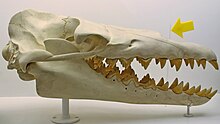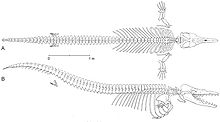Basilosauridae
| Basilosauridae | |
|---|---|

| |
| Skull of the genus Saghacetus. | |
| Scientific classification | |
| Domain: | Eukaryota |
| Kingdom: | Animalia |
| Phylum: | Chordata |
| Class: | Mammalia |
| Order: | Artiodactyla |
| Infraorder: | Cetacea |
| Family: | †Basilosauridae Cope 1868[1] |
| Genera | |
|
See text | |
Basilosauridae is a
Characteristics



Basilosaurids ranged in size from 4 to 16 m (13 to 52 ft) and were fairly similar to modern cetaceans in overall body form and function.
As archaeocetes, Basilosaurids lacked the telescoping skull of present whales. Their jaws were powerful,
Unlike modern whales, basilosaurids possessed small hindlimbs with well defined femur, lower leg and feet. They were, however, very small and did not articulate with the vertebral column, which also lack true sacral vertebrae.[3] While they were unable to support body weight on land, they might have assisted as claspers during copulation.[10] Analysis of tail vertebrate from Basilosaurus and Dorudon indicate they possessed small flukes.[11]
Taxonomy
Basilosaurinae was proposed as a subfamily containing two genera: Basilosaurus and Basiloterus.[12] They were characterized by elongated distal thoracic vertebrae, lumbar, and proximal sacrococcygeal. All known members of the subfamily are larger than their relatives of the Dorudontinae subfamily except Cynthiacetus.
Size
Basilosaurids have a diverse range of sizes. Tutcetus rayanensis, the smallest member, is about 2.51-2.55 meters (8 feet 3 inches - 8 feet 4 inches) long and weighs around 180.4-187.1 kilograms (398-412 pounds).[13] On the other hand, Basilosaurus cetoides is impressively long, reaching approximately 18 meters.[14] The largest known basilosaurid, Perucetus colossus, is believed to be even bigger, with a length of about 17–20 metres (56–66 ft) and possibly comparable to, if not larger than, the modern blue whale in terms of weight,[15] though other researchers argue that it was much lighter.[16][17]
Systematics
- Family Basilosauridae
- Subfamily Basilosaurinae
- Genus Basilosaurus
- Genus Basiloterus
- Subfamily Dorudontinae
- Genus Ancalecetus
- Genus Chrysocetus
- Genus Cynthiacetus
- Genus Dorudon
- Genus Masracetus
- Genus Ocucajea
- Genus Saghacetus
- Genus Stromerius
- Genus Supayacetus
- Genus Zygorhiza
- Subfamily Pachycetinae
- Genus Pachycetus
- Genus Antaecetus
See also
Notes
- ^ a b c Basilosauridae in the Paleobiology Database
- ^ Fostowicz-Frelik 2003
- ^ a b c Uhen 2002
- ^ Buono M, Fordyce R.E., Marx F.G., Fernández M.S. & Reguero M. (2019). "Eocene Antarctica: a window into the earliest history of modern whales". Advances in Polar Science 30(3): p. 293-302. doi:10.13679/j.advps.2019.0005
- PMID 33507304.
- S2CID 230110031.
- ^ Uhen M. (2004). "Form, Function, and Anatomy of Dorudon Atrox (Mammalia, Cetacea): An Archaeocete from the Middle to Late Eocene of Egypt". Papers on Paleontology 34: p. 1-222
- ISBN 9780253345479.
- ^ Snively E, Fahlke J.M. & Welsh R.C. (2015). "Bone-Breaking Bite Force of Basilosaurus isis (Mammalia, Cetacea) from the Late Eocene of Egypt Estimated by Finite Element Analysis". PLOS ONE 10(2): e0118380
- ^ Gingerich P.D., Smith B.H., Simons E.L. (1990). "Hind limbs of eocene basilosaurus: evidence of feet in whales". Science 249(4965): p. 154–157. doi:10.1126/science.249.4965.154
- ^ Philip D. Gingerich, Mohammed Sameh M. Antar und Iyad S. Zalmot: "Aegicetus gehennae, a new late Eocene protocetid (Cetacea, Archaeoceti) from Wadi Al Hitan, Egypt, and the transition to tail-powered swimming in whales". PLoS ONE 14(12): e0225391 doi:10.1371/journal.pone.0225391
- ^ Basilosauridae in the Paleobiology Database. Retrieved July 2013.
- PMC 10415296.
- .
- ISSN 1476-4687.
- PMC 10909350.
- ^ Zimmer, Carl (29 February 2024). "Researchers Dispute Claim That Ancient Whale Was Heaviest Animal Ever - A new study argues that Perucetus, an ancient whale species, was certainly big, but not as big as today's blue whales". The New York Times. Archived from the original on 29 February 2024. Retrieved 1 March 2024.
References
- OCLC 4909181381.
- Fostowicz-Frelik, Łucja (2003). "An enigmatic whale tooth from the Upper Eocene of Seymour Island, Antarctica" (PDF). Polish Polar Research. 24 (1): 13–28. S2CID 2617769.
- Gingerich, Philip D (2007). "Stromerius nidensis, new archaeocete (Mammalia, Cetacea) from the Upper Eocene Qasr El-Sagha Formation, Fayum, Egypt" (PDF). Contributions from the Museum of Paleontology. 31 (13): 363–78. OCLC 214233870.
- Uhen, Mark D (2002). "Basilosaurids". In Perrin, William R; Wiirsig, Bernd; Thewissen, J G M (eds.). Encyclopedia of Marine Mammals. Academic Press. pp. 78–81. ISBN 978-0-12-551340-1.
- Uhen, Mark D. (2013). "A review of North American Basilosauridae". Alabama Museum of Natural History Bulletin. 31 (2): 1–45.
